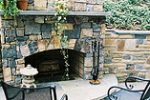September Home-Maintenance Checklist
Posted by Matt Brooke on September 15, 2011

September has arrived and it feels great with crisp morning air. Days are gradually getting shorter and a sense of purpose is upon us for preparing for the colder months ahead. DogGoneHandy has created a list of projects that will help you focus on priorities for fall.These tasks are all easy for the DIY’ers in the family. For those of you who are professionals at your workplace and not in the home, you can always call us for a helping hand.
Add Weatherstripping to Doors and Windows
Weatherstripping can be plastic, foam, felt or metal; its job is to seal small gaps, keeping moisture and cold air outside where they belong. Look around your doors and windows: Is the weatherstripping torn or missing? This can become expensive if ignored. On doors, make sure the bottom seal is working properly — there are many sweeps, gaskets and thresholds designed to seal this gap. Doors generally need weatherstripping in their jambs as well. Adhesive-backed foam pads are easy to install for this purpose. Newer, energy-efficient windows generally don’t require added weatherstripping, but if your windows are older, weatherstripping can keep drafts at bay and energy costs down.
Check Storm Windows
If you have storm windows that are cracked or dirty, repair and clean them now — prior to autumn installation.
Insulation Speculation
This is a good time to check the condition of insulation and see if you need more, especially if you live in an older home. You can purchase un-backed or loose-fill insulation if you are just beefing up what is already there. If you are adding batted insulation to a spot that has none, remember that the foil-backed side is the vapor barrier, and it must face the heated area. For example, if you are laying fiberglass insulation in an unfinished attic floor to keep heat in the living room below, you should see pink when you’re done — not foil! If your walls lack insulation, consider having a professional install blown-in insulation foam. The energy savings will probably offset the cost of the procedure in a couple of years.
Check Gutters
Do a quick visual check to make sure gutters are clear — they’ll be performing double duty soon with rainstorms and falling leaves.
Keep Critters Out
September inspires nesting in mice as well as humans. Mice are looking for a winter home now, and that newly insulated attic would be just the spot. Mice can squeeze through 1/4-inch openings; rats need a half-inch. Make sure all exterior vents are screened, and that there are no gaps underneath garage doors. If you are careless about leaving doors and windows open this time of year, you’ll be setting mousetraps later. Pet doors are another favorite access point for rodents.
Caulk Exterior
Think of caulk as weatherstripping in a tube. Any gap on the outside of your home can be a candidate for caulking. Look at transition spots: corners, windows, doors, areas where masonry joins siding, or places where vents and other objects protrude from walls. Carefully read manufacturer’s directions to make sure the caulk you buy will work where you plan to use it, and don’t forget to purchase a caulking gun. Early fall is a good time for this task because caulk becomes difficult to apply when the temperature falls.
Wood for Fireplaces
Though most of us buy whatever’s local, bear in mind that soft woods like fir and cedar burn faster and create hazardous creosote in the chimney, thus requiring more system maintenance and more wood. Hard woods like oak, hickory and maple are slow, hot, clean burners. Wood piles attract insect and animal pests, so stack wood away from the house. Wood dries best when it’s protected from rain and has air circulating around it, so under the roof of a wall-less carport would be an ideal wood storage spot.
Clean Dryer Vent
This is another one of those tasks that should be on your to-do list every six months. Scoot your clothes dryer away from the wall, unplug it, and vacuum behind it. (If it’s a gas dryer, turn off the gas supply to the dryer at the appliance shutoff valve.) Unhook the tube that leads to the vent and clear as much lint from the tube as you can. Grab a shop vacuum, go outside, and tackle the outside dryer vent as well.
Inspect Your Roof & Chimney
If your roof isn’t too steep, and isn’t covered with slate or tile, you may be able to carefully walk on it on a dry day. Look for broken or missing shingles, missing or damaged flashing and seals around vent pipes and chimneys, and damage to boards along the eaves. Also peer down your chimney with a flashlight to make sure no animals have set up house in it. If you can’t get on your roof, perform this inspection with a ladder around the perimeter. Pay close attention to valleys and flashings — many leaks originate in these spots. Some patches and roofing cement now can prevent thousands of dollars of water damage later in the winter.
If by chance the weather got to your house before you could, we can definitely help you with wood rot repair too.







